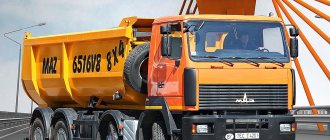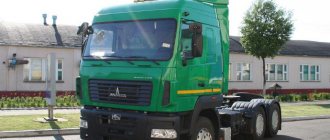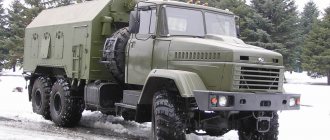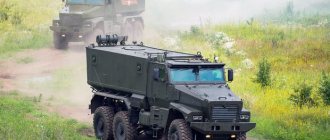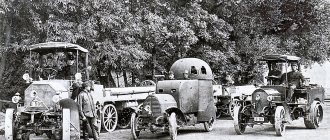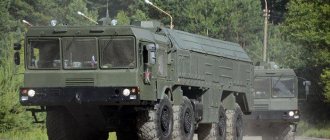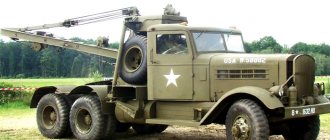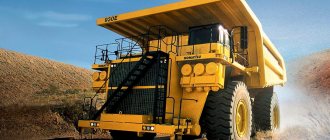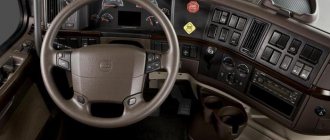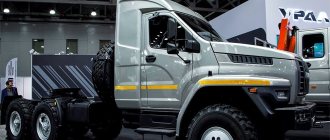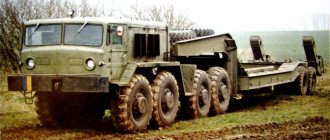Scraper equipment and what is it used for?
The scraper is a cyclic earth-moving and transport machine designed for layer-by-layer cutting of soil, transporting it to the place of laying and unloading into a structure or dump. The rational range of longitudinal soil movement for trailed scrapers is up to 500 m and for self-propelled scrapers - up to 2 - 3 km, and in some cases - up to 5 km.
In construction, scrapers are used for constructing embankments, constructing earthen dams and excavations, and grading large areas.
The cost of developing soil with scrapers is significantly less than the cost of developing soil with excavators and hauling dump trucks (by about 25%).
The scraper is a two-axle or single-axle machine attached to a tractor on pneumatic wheels with a tipping bucket. When lowering, the bucket cuts into the ground with its cutting edge and, as it moves, continuously cuts off the layer of soil entering the bucket. When filling, the bucket is closed with a flap.
The scraper operation cycle consists of the following operations: cutting the soil while simultaneously filling the bucket, transporting the soil, unloading the bucket and returning the scraper to the mining site.
Scrapers are distinguished by bucket capacity, method of movement, methods of loading and unloading the bucket, type of front damper, and control system.
According to the bucket capacity, scrapers differ in small capacity - up to 3 m3, medium capacity - from 3 to 10 m3, large capacity - over 10 m3.
According to the method of movement, scrapers are distinguished as trailed to tracked or wheeled tractors; semi-trailer, part of the load of which from its own weight and the weight of the soil is transferred to the tractor (tractor); self-propelled, in which the tractor and scraper are one machine; self-propelled scraper trains consisting of two or three scraper units.
The classification of semi-trailer scrapers attached to a single-axle tractor into the group of self-propelled ones is quite arbitrary, since their design may not differ from those attached to a two-axle tractor.
According to the method of loading the bucket, scrapers are distinguished with loading from traction force, with mechanized elevator loading, and with the elevator driven by cardan shafts from the tractor power take-off shaft.
According to the method of unloading the bucket, scrapers are distinguished with free (tipping) unloading forward or backward, used on small-capacity buckets; with semi-forced unloading, in which the bucket is emptied by turning the bottom and rear wall, made as one whole; with forced unloading of the bucket towards the unloading side.
According to the control system, scrapers are distinguished between hydraulically controlled and rope-controlled. Due to the greater efficiency of hydraulically operated scrapers, rope operated scrapers are still in use but are no longer produced.
Self-propelled scrapers are increasingly used in the construction industry. High transport speed of up to 40 - 50 km/h and good maneuverability ensure an increase in their productivity compared to trailed scrapers for crawler tractors by 2 - 3 times. It is advisable to move soil with self-propelled scrapers over a distance of up to 5 km.
Cutting the soil and filling the bucket of a self-propelled scraper is performed on medium and heavy soils using a pusher. The pusher can be a caterpillar tractor or a wheeled tractor equipped with pushing devices. At the face, one pusher can serve 3 - 5 scrapers.
Scraper performance.
The technical productivity of scrapers (m3/h) is determined by the formula
The average annual production rate of scrapers varies depending on the geographical location of work from 5 to 12 thousand m3 per 1 m3 of bucket capacity.
Determination of forces acting on the working body of the scraper. The total resistance to movement of the working body of the scraper is defined as the sum of the resistances of the cutting force Рр, the resistance to friction of the knife on the ground Ррр, the dragging resistance force of the prism Рр and the resistance to filling the bucket.
Resistances Рр and Рtr are determined in the same way as for a bulldozer. The volume of the drawing prism is assumed to be 0.6 H2B and the drawing resistance is 0.6 HBu, where / for cohesive soils is 0.5, and for non-cohesive soils - 0.6.
The resistance to filling the bucket P3ap, equal to 0 at the beginning of filling, has a maximum value at the end of filling the bucket and is the sum of the gravity resistance of the soil column.
Technical characteristics of scrapers. The main indicator of the technical characteristics of a scraper is the capacity of the bucket. Scrapers are produced with buckets with a capacity of 2.85 to 25 m3. Speed of movement of a scraper with a load: trailed - up to 2 - 5 km/h, self-propelled - up to 30 km/h; designs of scrapers with buckets up to 45 m3 are known.
Parameters and technical requirements for scrapers are regulated by GOST 10055 - 75* and GOST 5738 - 73.
Two-wheeled soldiers: secret single-axle tractors of the Soviet army
In the title photo: The first Minsk single-axle tractor MAZ-529 with a front road wheel (from the MZKT archive)
Self-propelled scrapers with MoAZ-546P tractors leave the gates of the Mogilev Automobile Plant (from MoAZ Avenue)
Heavy single-axle tractors were unusual vehicles for their time with a 2x2 wheel arrangement, a single drive axle and two large-diameter unsteered wheels. A hinged fifth wheel was mounted in the middle part of the frame, on which the front of a semi-trailer with non-driving wheels rested. The machine was turned by a conventional steering wheel using two hydraulic cylinders, which changed the degree of mutual deflection of the front and rear sections by an angle of more than 90° in both directions.
Single-axle tractor MAZ-529E with an 8U237 unit and a hydraulic crane for installing a ballistic missile in a mine well
MAZ-529 family
It is little known that the second vehicle after the 528 model, developed in the secret SKB-1 of the Minsk Automobile Plant, was the MAZ-529 single-axle road construction tractor for operation as part of the D-357 self-propelled scraper, originally designed for military use. You can see him in the title photo of the article.
This was the first work of Vladimir Efimovich Chvyalev, the future chief designer of multi-axle rocket carriers. In 1956, his first-born received a 120-horsepower two-stroke diesel engine YaAZ-204A from a MAZ-200 truck, a manual four-speed gearbox and final drives in the hubs of both wheels. In 1958, upon completion of acceptance tests, the modernized version of the MAZ-529V was transferred for mass production to the Mogilev Automobile Plant named after S. M. Kirov (MoAZ).
Experienced 120-horsepower MAZ-529 tractor as part of the D-357 self-propelled scraper (from the MZKT archive)
A year later, in Mogilev, the assembly of the basic and most common MAZ-529V tractor began with a YaAZ-206A diesel engine of 180 hp, a five-speed gearbox, an all-metal cabin and huge wheels with 28-inch tires, rigidly attached to the car frame. Its maximum speed when fully loaded was limited to a maximum of 40 km/h. The car passed state tests at 21 Research Institutes and was adopted by the Soviet Army.
| Serial 180-horsepower MAZ-529V tractor with a new D-357G scraper | Multi-purpose 205-horsepower vehicle MAZ-529E with scraper D-357G |
Subsequently, MoAZ created new versions of dual-purpose tractors, which were not fundamentally different from the base vehicle and served to work as part of the first Soviet serial self-propelled scraper D-357G and tow a semi-trailer 20-ton earth-cart D-504. For military needs, the most important was the more powerful version of the MAZ-529E with a 205-horsepower YAZ-206K engine, which served in the missile forces.
Modernized MAZ-529V tractor with D-504 earth-carrying bogie
Tractor MoAZ-546P
In the early 1960s, a test batch of MoAZ-546 single-axle tractors with leaf spring suspension and an updated appearance was assembled in Mogilev. In 1969, a modified version of the MoAZ-546P with a YaMZ-238A diesel engine with a capacity of 215 hp. With. entered production to replace the 529 series. As part of the D-357P scraper, it was used in the national economy and engineering and construction units of the Soviet Army, and in the Strategic Missile Forces it continued to perform the main functions of previous single-axle vehicles.
Multi-purpose scraper D-357P with a 215-horsepower MoAZ-546P tractor (from the MoAZ prospectus)
Self-propelled scraper D-357P at a demonstration in the People's Army of the GDR
Rocket launchers
The main military purpose of Soviet single-axle tractors was to tow secret transport and installation units (installers) for mounting ballistic missiles at launch positions. They were long-wheelbase road trains with two-axle low-bed semi-trailers with a welded spar frame, resting with the front part (trunk) on the vehicle's coupling device.
Semi-trailer unit 8U210 in transport position with MoAZ-546P tractor
For ground-based systems, they were equipped with a portal reloading mast to lift the rocket into a vertical position. Silo-based systems used more complex structures capable of lowering a missile into launch wells. The stability of such units was ensured by retractable supports and steel anchors concreted into the installation site.
For the first time, installers with single-axle tractors began to use R-12 mass ballistic missiles with thermonuclear warheads for installation on a ground launch site. For this purpose, an 8U210 unit with a U-shaped mast and a system of cable pulleys was used, working in conjunction with MAZ-529V and MoAZ-546P tractors. In 1962, as part of Operation Anadyr, these systems were transported by sea to Cuba, which became the cause of the famous Caribbean crisis.
| Installer 8U210 on the launch pad during installation of the R-12 rocket | Diagram of the 8U210 unit when installing the R-12 ballistic missile |
To work with R-14 ballistic missiles, modernized 8U224 vehicles with a more advanced balancing system were created.
Installation of the R-14 missile using the 8U224 unit with the MAZ-529V tractor
At the stage of using the new silo-based ballistic missiles R-12U and R-14U, 8U237 installers with a powerful lifting telescopic structure and longitudinal guides were used, along which the transport-launch container and missile warhead were lowered into the silo well.
Option 8U224M was equipped with a more complex cable-pulley reloading system
Installation of the R-14U missile warhead using the 8U224M installer
Their development was the heavy transport and installation unit 8T178 with an extended sliding lifting frame for transporting, assembling and reloading the two-stage R-36 intercontinental missile onto a stationary launcher.
R-36 missile on an 8T178 transport and installation unit with a MAZ-529E tractor (from the MZKT archive)
Installation diagram of the R-36 intercontinental missile in the silo well of the 8P867 complex
In accordance with the 1987 Soviet-American Treaty on the Elimination of Intermediate-Range Missiles (INF), all complexes with missiles of the R-12/R-14 family, along with installation units, were destroyed. By that time, these outdated systems had already given way to four-axle tractor units with special semi-trailers.
Missile support vehicles
On low-frame single-axle platforms with MAZ-529E and MoAZ-546P tractors, military 10-ton semi-trailer boom truck cranes with hydraulically driven working parts were created, which performed loading and unloading operations in various units of the Soviet army. The most common version of the 8T26 for the Strategic Missile Forces was used in the reloading, assembly and installation of first-generation ballistic missiles.
| Military crane 8T26 with MAZ-529E tractor (from the archives of NIITs AT) | 8T26 truck crane with MoAZ-546P tractor during reloading of R-12U missile |
For the delivery and distribution of rocket fuel at launch sites, special semi-trailer refueling tanks 8G132 with their own pumping and control equipment were used.
MAZ-529E with semi-trailer tanker 8G132 (from the archives of NIITs AT)
MoAZ-546P with a special warehouse semi-trailer van SPS-2
Articles / Military equipment A giant on the sidelines: the secret Oplot missile tractor In the history of the Soviet military industry, there were many cases when an experimental vehicle with a number of original technical solutions failed military acceptance. There are many promising military... 28278 2 11 12/16/2016
In the 1970s, the out-of-service installers became the base for special mobile SPS warehouses with semi-trailer vans for the delivery of replacement equipment and spare parts for Pioneer missile systems and the deployment of storage facilities in the field.
Airfield and railway vehicles
When military interest in single-axle tractors waned, they were reoriented to serve large civilian and military airports. This is how powerful cleaning machines appeared for clearing debris, snow, dust, ice and subsequent drainage of runways and taxiways of airfields, test centers and rocket launch sites.
In the 1970s, the DE-224 airfield cleaning machine became the most common, cleaning a strip more than five meters wide in one pass. Its working parts were a front blade, a rotating brush and a gas turbine engine from an Il-18 aircraft, which created a stream of hot air to dry the cleaned strips. The productivity of this 31-ton machine reached 80 hectares of surface per hour. More than 20 units were built.
Airfield cleaning vehicle DE-224 with MoAZ-546P tractor (photo by the author)
Experimental airfield vehicle DE-229 with an aircraft engine and control cabin
In 1978, a prototype of the DE-229 gas-jet cleaning machine was created, which cleared airfield areas with powerful streams of hot air from two gas turbine engines of the Tu-124 aircraft. In 1986, on the new DE-235 model, they returned to an autonomous motor for driving the brush and air fan.
In the 1980s, for the railway troops, Bryansk Plant No. 192 assembled a mobile track-laying unit MPA with a MoAZ-546P tractor, towing a special semi-trailer with a wheeled trolley moving along the sleepers.
Semi-trailer railway track layer MPA with MoAZ-546P tractor
At the rear, a movable caterpillar support with a hydraulic crane was attached to it for bending the rail links with sleepers and installing them on the prepared section of the track. At one time, this unit was considered a revolutionary Soviet development, superior to foreign analogues.
Tractor units KZKT-932 “Zauralets”
(photos from the archives of NIITs AT)
In 1963, on instructions from the USSR Ministry of Defense, the Kurgan Wheel Tractor Plant (KZKT) assembled two experimental tractors KZKT-932 or Zauralets-932, which were planned to replace the MAZ-529 family. The first two-axle version E932 and single-axle 2E932, unified with MAZ-537 tractors, were equipped with a 360-horsepower V12 diesel engine and a hydromechanical gearbox.
Experimental 360-horsepower two-axle tractor KZKT-E932 “Zauralets”
Their technical innovations included disc wheel brakes, independent hydropneumatic suspension and an air supercharger that created excess pressure in the cabins to protect against toxic substances. During testing, 217 problems and defects were discovered in the tractors, which forced them to stop ahead of schedule.
In the winter of 1967–1968, two modernized versions of the KZKT-932A (“Zauralets-932A”) of different designs appeared. Sample 3E932 was equipped with a mechanical drive of semi-trailer wheels, version 4E932 received an electric transmission. According to the results of the next tests, the first car was rejected, and the “electric” road train 4E932 was recognized as the most promising.
Single-axle tractor KZKT-4E932 "Zauralets-932A" with mechanical drive of semi-trailer wheels
For the KZKT-4E932 vehicle, in addition to the standard diesel engine, an 85 kW electric generator was installed, which supplied current to the traction electric motor of the semi-trailer, which rotated the gearbox system, the main gears of both axles and wheel gearboxes. And in this version, during testing, many defects and cases of non-compliance with military requirements were discovered. Thus, the curb weight of the tractor of 13.3 tons exceeded the design specification by more than one ton, and the loaded road train turned out to be prohibitively heavy - 52 tons.
The second prototype of the Zauralets-932A tractor with an electric transmission
Road testing of the KZKT-4E932 tractor with electric drive of semi-trailer wheels
Testing of the 16-meter “electric” road train “Zauralets-932A” on the ground
The modest design and production capabilities of KZKT did not allow further development of the Zauralets project. In May 1969 it was closed.
The author expresses gratitude to Yu. D. Babushkin, a member of the editorial board of the catalogs “Weapons of Russia 1996–1997,” for the materials provided.
Characteristics and functional features of the skipper
Scrapers must be manufactured in accordance with the requirements of this standard and technical specifications for specific models of scrapers, according to working drawings approved in the prescribed manner.
Climatic modifications and the placement category of scrapers must comply with GOST 15150. The design of scrapers must ensure:
forced unloading of the bucket;
the ability to work with a pusher tractor when digging (scrapers with traction loading), as well as when leaving the face:
rotation of the tractor (tractor) in plan at an angle of at least 85° in each direction and lateral tilt of the tractor in the vertical plane relative to the bucket at an angle of at least 10° in each direction;
work without refueling - at least 10 hours;
installation of devices for operation in accordance with GOST 28634;
diagnostics in accordance with the requirements of GOST 27518, GOST 25044, while specific requirements for adaptability to diagnostics and the level of automation of the diagnostic process must be established in the technical specifications for specific scraper models;
the presence of places for inserting instruments and devices for diagnostic checking of technical condition, while the list of instruments and devices is established in the technical specifications for scrapers of specific models in accordance with the requirements of GOST 27253 and customer requirements.
By agreement with the customer, the scraper design can provide:
installation of a device for starting the engine at subzero temperatures;
installation of an automatic stabilization system for the position of the cutting edge of the bucket.
The location and main dimensions of scraper trailers are in accordance with GOST 3481 and GOST 17595.
Scraper knives - according to GOST 28771.
The dimensions of the filler necks of fuel tanks are in accordance with GOST 27533.
Drain, fill and control plugs - in accordance with GOST 27720.
Note. By agreement with the customer, it is allowed to use plugs with dimensions in accordance with industry standard documentation on components produced by other industries.
Lubricating oilers - according to GOST 19853.
Ergonomic and safety requirements are in accordance with GOST 12.2.011, GOST 27921.
The steering of wheeled scrapers with a maximum speed of over 20 km/h must comply with GOST 27254.
Brake systems must comply with GOST 28769.
The design of the scraper, at the request of the consumer, must provide the ability to install a protective device for the driver when the scraper rolls over (ROPS) in accordance with GOST 27714 and against falling objects (FORS) in accordance with GOST 27719. The design of the scraper must ensure visibility of the working parts in all technological positions.
External lighting devices of machines with a maximum speed of over 25 km/h must comply with GOST 8769 and provide the necessary illumination when moving along the road, as well as the necessary illumination of the working area in addition to its general illumination. Electric lighting devices for cars with a maximum speed of up to 25 km/h - according to the technical specifications for cars of specific models, provided that the level of illumination is ensured.
Signal colors and safety signs must comply with GOST 12.4.026.
Electrical equipment must comply with GOST 12.2.007.0 and GOST 3940. Installation and fastening of electrical wiring must prevent damage to its insulation. The electrical system must have a device to disconnect the battery.
The engine fan must be equipped with a guard. The guard must not bend towards the rotating blades and must protect the operator from accidental contact with the fan blades.
At a pressure in the hydraulic system of more than 5000 kPa, at a working fluid temperature of more than 50 °C, high-pressure hoses located in the cabin within 0.5 m of the driver must have protective devices that ensure the safety of the driver in the event of their rupture.
The design of the access system must comply with GOST 29100 and ensure the safety of lifting, operator entry to the workplace and maintenance of the scraper.
Scraper wheel fenders used for access must not have sharp edges, their surface must not be slippery and they must withstand a vertical load of at least 1500 N.
The seat belt system (if equipped) must be mounted as specified in the application.
The engine exhaust system must ensure that sparks are extinguished before the exhaust gases escape into the atmosphere. The exhaust gas stream must not be directed towards the operator or flammable materials.
Breakthrough of gases and sparks at the joints is not allowed.
The sound alarm system of scrapers must comply with GOST 29292.
Coating of the internal surfaces of the cabin according to class IV, other surfaces according to class VI - in accordance with GOST 9.032, group of operating conditions - in accordance with GOST 9.104.
Maintenance and repair requirements
It is recommended to provide the following in the scraper design:
possibility of unit repair;
use of group and crankcase lubrication systems. Individual lubrication is permitted (with preference for long-term lubrication);
Shift maintenance by one operator.
Requirements for adaptability to maintenance, as well as a list of systems and components subject to maintenance, are established in the technical specifications for scrapers of specific models.
Completeness
The scraper kit includes:
a set of spare parts and tools according to the spare parts list;
operational documentation in accordance with GOST 2.601, including for self-propelled scrapers: operating instructions containing technical and operational characteristics in accordance with GOST 27536, maintenance instructions, installation instructions, form; for trailed scrapers - passport in accordance with GOST 2.601.
Trailed scrapers can be supplied with or without a tractor.
Marking
Each scraper must have a marking plate attached to it in accordance with GOST 12969, containing the following data:
name of the manufacturer or its trademark;
scraper index and serial number;
designation of the regulatory document according to which the scraper is manufactured.
Each piece of cargo must be marked with transport markings in accordance with GOST 14192.
Package
Packaging requirements must be established in the technical specifications for specific scraper models in accordance with the requirements of GOST 27252 and GOST 9.014.
